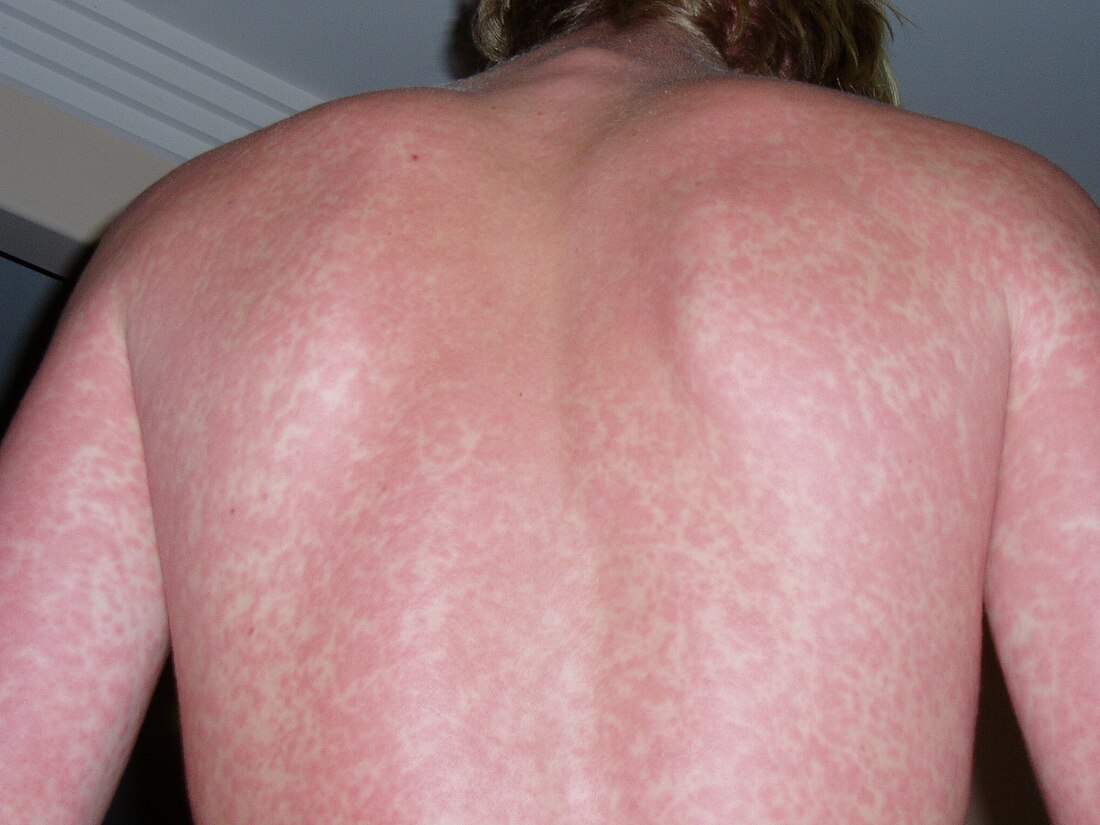Top Qs
Timeline
Chat
Perspective
Rash
Change of the skin that affects its color, appearance, or texture From Wikipedia, the free encyclopedia
Remove ads
A rash is a change of the skin that affects its color, appearance, or texture.
This article needs additional citations for verification. (January 2008) |
This article about biology may be excessively human-centric. |
Remove ads
A rash may be localized in one part of the body, or affect all the skin. Rashes may cause the skin to change color, itch, become warm, bumpy, chapped, dry, cracked or blistered, swell, and may be painful. The causes, and therefore treatments for rashes, vary widely. Diagnosis must take into account such things as the appearance of the rash, other symptoms, what the patient may have been exposed to, occupation, and occurrence in family members. The diagnosis may confirm any number of conditions. The presence of a rash may aid diagnosis; associated signs and symptoms are diagnostic of certain diseases. For example, the rash in measles is an erythematous, morbilliform, maculopapular rash that begins a few days after the fever starts. It classically starts at the head, and spreads downwards.
Remove ads
Differential diagnosis
Summarize
Perspective
Common causes of rashes include:
- Food allergy
- Medication side effects[1][2]
- Anxiety
- Allergies, for example to food, dyes, medicines, insect stings, metals such as zinc or nickel; such rashes are often called hives.
- Skin contact with an irritant
- Fungal infection, such as ringworm
- Balsam of Peru[3]
- Skin diseases such as eczema or acne
- Exposure to sun (sunburn) or heat
- Friction due to chafing of the skin
- Irritation such as caused by abrasives impregnated in clothing rubbing the skin. The cloth itself may be abrasive enough for some people
- Secondary syphilis
- Poor personal hygiene
Uncommon causes:
- Autoimmune disorders such as psoriasis
- Lead poisoning
- Pregnancy
- Repeated scratching on a particular spot
- Lyme disease
- Scarlet fever
- COVID-19 (see Symptoms of COVID-19 § Other)
Conditions
Remove ads
Diagnostic approach
Summarize
Perspective

The causes of a rash are numerous, which may make the evaluation of a rash extremely difficult. An accurate evaluation by a provider may only be made in the context of a thorough history, i.e. medications the patient is taking, the patient's occupation, where the patient has been and complete physical examination.[citation needed]
Points typically noted in the examination include:[citation needed]
- The appearance: e.g., purpuric (typical of vasculitis and meningococcal disease), fine and like sandpaper (typical of scarlet fever); circular lesions with a central depression are typical of molluscum contagiosum (and in the past, small pox); plaques with silver scales are typical of psoriasis.
- The distribution: e.g., the rash of scarlet fever becomes confluent and forms bright red lines in the skin creases of the neck, armpits and groins (Pastia's lines); the vesicles of chicken pox seem to follow the hollows of the body (they are more prominent along the depression of the spine on the back and in the hollows of both shoulder blades); very few rashes affect the palms of the hands and soles of the feet (secondary syphilis, rickettsia or spotted fevers,[8] guttate psoriasis, hand, foot and mouth disease, keratoderma blennorrhagicum);
- Symmetry: e.g., herpes zoster usually only affects one side of the body and does not cross the midline.
A patch test may be ordered, for diagnostic purposes.[9]
Remove ads
Treatment
Treatment differs according to which rash a patient has been diagnosed with. Common rashes can be easily remedied using steroid topical creams (such as hydrocortisone) or non-steroidal treatments. Many of the medications are available over the counter in the United States.[10]
The problem with steroid topical creams i.e. hydrocortisone; is their inability to penetrate the skin through absorption and therefore not be effective in clearing up the affected area, thus rendering the hydrocortisone almost completely ineffective in all except the most mild of cases.[11]
References
External links
Wikiwand - on
Seamless Wikipedia browsing. On steroids.
Remove ads

